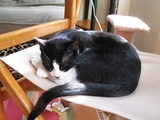When Vernon and Master Lin-chi joined my household I began to think seriously about cat nutrition. I looked at several websites and one book on the subject and began to inform myself.

The first thing you discover: a close reading of the nutritional analysis suffices to establish that commercial catfood is basically crap. Even the high end stuff is wanting.
Then there are the myths. Dry cat food? Worse than the moist. But isn’t it good for their teeth? No it isn’t. What about kitten, adult and “senior” cat food varieties? Total bullshit. 
Catfood manufacturers cynically exploit cat owners’ ignorance by extolling the wholesome goodness of their products containing cranberries and such. They must surely know that cats are obligate carnivores and have no use for cranberries, brown rice, seaweed, etc., no matter how wholesome-sounding. Shamefully, some veterinarians collude with these catfood manufacturers.
So what’s a cat owner to do? Well, what have cats done historically, before catfood was invented? Domestic cats lived by hunting and table scraps. Modern feral cats essentially do the same. My urban cats live strictly indoors; they get no birds and few if any mice in their diets. Table scraps won’t do it, as I eat little meat. My ziti with carmelized onions and broccoli rabe is of little use to them. It’s up to me to simulate something close to their natural diet by providing them with fresh meat and organs purchased for that purpose.
I read about people buying meat grinders and grinding up turkey, chicken and rabbit and feeding it to their cats. This sounded like a cool idea so I got myself a grinder, and promptly broke it on a turkey bone. While procrastinating about calling the manufacturer and inquiring about a repair, I tried paying top-dollar for something called Carnivore Diet, five-pound tubes of ground beef and bone. This seemed like the real deal, and the cats loved it, although there is something unnatural about domestic cats feeding off an animal so many times their size. And at over $15 for the five pounds, it was expensive.
While continuing to procrastinate about the grinder repair, I came across other websites that said grinding is nonsense. When you increase all that surface, you facilitate the growth of taurine-eating bacteria. Do they eat ground mice and birds in the wild? No. The non-grinding school advocates taking things like raw chicken and chopping it into manageable pieces, bones included, and giving to your cats. Ah ha! This approach has the irresistible appeal of Ockham’s Razor. Who would have thought that the best way to feed your cat also happens to be the simplest? Get out your meat cleaver and a solid cutting board. Get a chicken or some turkey parts. Hack into pieces. Serve. For dietary balance give them some beef hearts, chicken livers, etc.
Considering cost, this solution compares favorably to the high-end commerical cat food. Perhaps it’s more expensive — if so, it’s worth it. People are fond of comparing pets to members of the family. Would you feed garbage to your human loved ones? Would you begrudge the expense of their nourishment? And to be strictly pragmatic about it, the savings on vet bills over your cat’s longer, healthier life helps offset the expense. (Of course, you could counter-argue that the cat’s extended life means more food consumption, ergo expense. But you’d probably get another cat who would also eat, so it’s a wash. Perhaps it boils down to how long you live. Cut your living expenses: smoke cigarettes.)
A further benefit of the raw flesh diet is that it’s satisfying for the owner. Nothing is more pleasing than the sound of their little jaws cracking bone, their growling as they warn each other away from their chunk of heart. This is real food. On the rare occasion when I run out of flesh and open a can, I am apalled at its contents: a gray and foul-smelling industrial sludge.
Month: April 2008
Case 37: The Oak Tree in the Garden

“Either you real or you ain’t”
The other day one of the teachers in our zendo gave a talk in which she likened the practice of zen to classical ballet: one of the most painfully demanding of disciplines. Dancers must show up for a 90 minute class every single day without fail, no matter how experienced and accomplished they are or think they are. Always showing up, always striving, tuning, preparing for the stage — that’s what it’s about. So it is with the Zen practitioner. You show up at the zendo for formal zazen as often as you possibly can, regardless of whether you feel like it or whether it’s convenient. Formal zazen is essential, a necessity. LIkewise, extended sittings such a as zazenkai and sesshin are not optional add-ons. They are what you do when you’re a Zen practitioner.
This idea was reinforced by a scene that I recently saw in an episode from the fifth season of the venerable HBO series The Wire. During a prison visit, the incarcerated father admonishes his son to apply himself with greater diligence to his work in the drug trade. Either you real or you ain’t, he says. Irony notwithstanding, this paternal advice underscores a valid point. The teacher’s talk was evidently aimed at students who she thought needed to hear it. She might as well have said, either you real or you ain’t.
I was reminded of something my family has said about me over the years: you are a fanatic, an addictive personality. When you set your mind to something, you go at it relentlessly, obsessively. I have always tended to think, well, ok. When they suggested that going away for a week-long sesshin last summer was an example of my fanaticism, I figured, whatever. Now I am not so sure. Sesshin is what zen practitioners do. Why do this at all unless you’re serious? Either you real or you ain’t.
Update
Looking at the above three months later, I see the fallacy in the argument “I am not a fanatic; sesshin is what Zen practitioners do.” Sitting in meditation several hours a day for a week is extreme — fanatical, even. Dedicated Zen practitioners are fanatics.
MLK’s Mountaintop Speech
There was a good piece on NPR this morning about Martin Luther King’s last speech, in which he said he was not concerned about longevity because he had been to the mountaintop and looked over. Just the night before I had been pondering the koan from which the phrase “All is vast and boundless” is taken. While listening to King’s speaking voice coming out of the radio in my kitchen 40 years after the fact, it occurred to me that King himself must have realized that all is vast and boundless. It doesn’t matter what you call it.